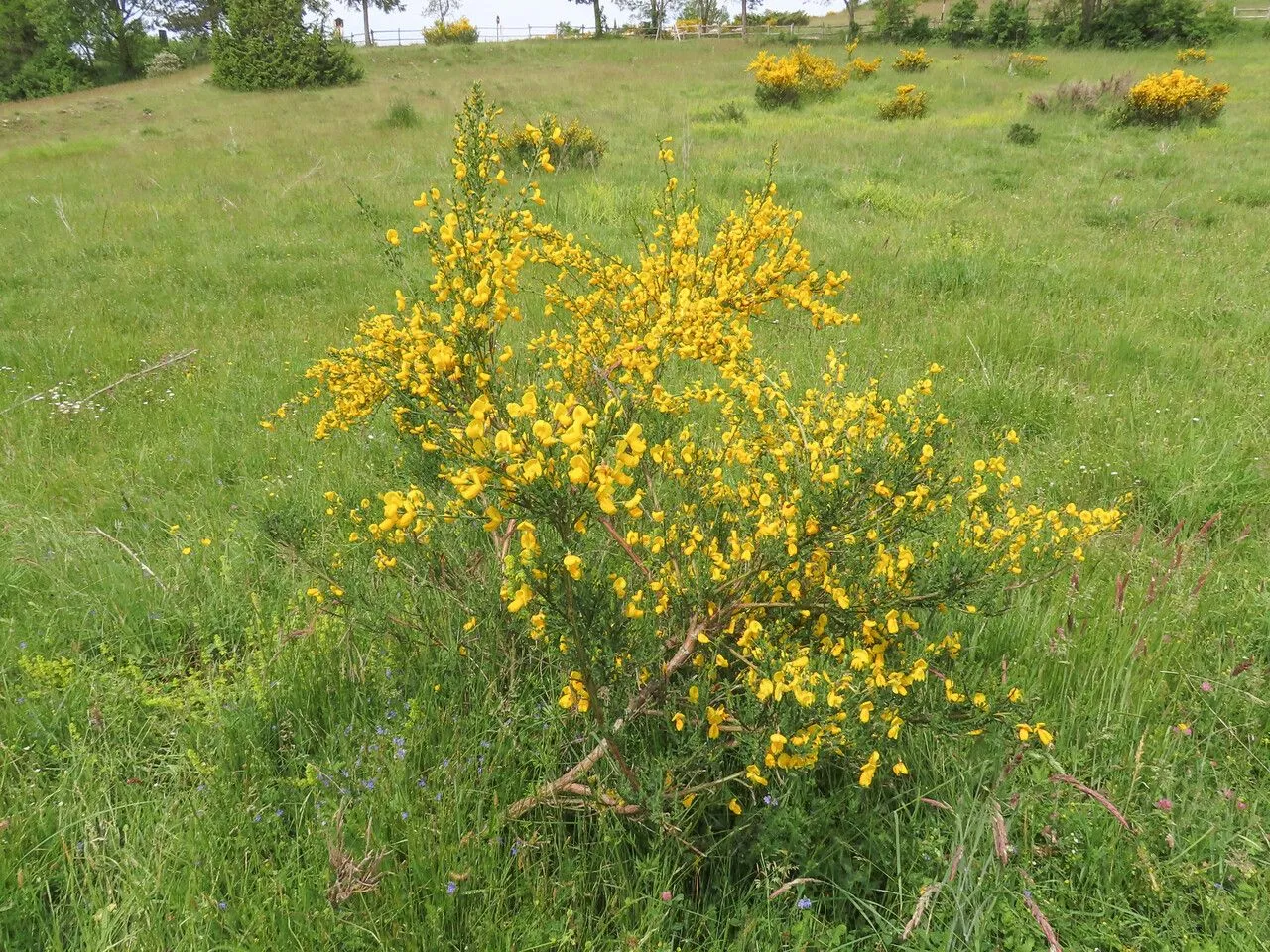
Author: (L.) Link
Bibliography: Enum. Hort. Berol. Alt. 2: 241 (1822)
Year: 1822
Status: accepted
Rank: species
Genus: Cytisus
Vegetable: False
Observations: Europe
European broom, known scientifically as Cytisus scoparius, is a perennial shrub that belongs to the Fabaceae family. First described in 1822 in the “Enumeratio Hortorum Berolinensis Altera” by the distinguished botanist (L.) Link, this plant has a rich history and notable presence in its native habitat.
Endemic to Europe, European broom is well-adapted to a variety of environmental conditions. It typically thrives in sunny locations with well-drained soils, such as sand dunes and open woodlands. Recognized for its signature vibrant yellow flowers, which bloom in late spring to early summer, this shrub significantly enhances the landscapes where it is found. The flowers attract a range of pollinators, contributing to the ecological diversity of its surroundings.
European broom is known for its hardy and robust nature. It possesses slender, green, and ridged stems, often forming dense thickets. This growth habit can be both beneficial and challenging, as it helps in soil stabilization but can also lead to invasive behavior in areas outside its native range.
The plant’s ability to fix nitrogen in the soil through symbiosis with root-nodule bacteria is another remarkable trait, enriching the earth and promoting the health of neighboring plant species. This natural fertilizing capability underscores its importance in both natural and managed ecosystems.
Although historically appreciated for its ornamental value and practical uses—such as in traditional broom-making—European broom requires careful management to prevent its spread and maintain ecological balance. It holds significant value in biodiversity but demands respect for its potential to become invasive.
The European broom’s resilience and ecological roles make it a fascinating subject of study within the plant world. From its striking appearance to its pragmatic uses, Cytisus scoparius remains a noteworthy member of the Fabaceae family, deeply rooted in the natural and botanical heritage of Europe.
Dan: almindelig gyvel, gyvel
Deu: besen-ginster, besenginster
Eng: english broom, european broom, irish broom, scotch broom, scotchbroom, scottish broom, broom, broomtops, common broom, scot’s broom
Afr: skotse brem
Ita: amaracciole, emero scornabecco, ginestra dei carbonai
Nld: brem
Fra: genêt à balais
Por: giesta
Nob: gyvel
Nno: gyvel
Swe: har-ris, harris, jänönvihma, harginst
Fin: jänönvihma
Cym: banadl, banadl cyffredin, banadlen, banhadlen, banhalen, banhallen, manal, ysgubell fanal
Gla: bealaidh, bealaidhean
En: European broom, Irish broom, Broom, Broomtops, Common broom, Scotch broom, Scottish broom, English broom, Scotchbroom, Scot’s broom, Bisom, Green Broom
Af: Skotse brem
Ca: Ginesta d’escombres, Ginestell comú
Zh: Jin que hua
Cs: Janovec metlatý
Da: Almindelig gyvel, Gyvel
Nl: Brem, Bezembrem, Gewone Brem
Fi: Jänönvihma
Fr: Genêt à balais, Cytise à balais, Genettier, Grand Genêt, Juniesse, Sarothamne, Spartier à balais, Genêt à balai
De: Besenginster, Besen-Ginster, Besenfrieme, Bram, Hasenginster, Rehheide
It: Ginestra dei carbonai, Amaracciole, Emero scornabecco, Alastra, Citiso scopario
Nb: Gyvel
Nn: Gyvel
Pt: Giesta
Gd: Bealaidh, Bealaidhean
Sk: Prútnatec metlovitý
Es: Escoba negra, Escobón, Hiniesta, Hiniesta de escobas, Retama de escobas, Retama negra
Sv: Har-ris, Harris, Jänönvihma, Harginst
Cy: Banadl, Banadl Cyffredin, Banadlen, Banhadlen, Banhalen, Banhallen, Manal, Ysgubell Fanal
Taken Jun 16, 2021 by Emanuele Santarelli (cc-by-sa)
Taken Mar 9, 2019 by Aitor Ramiro (cc-by-sa)
Taken Mar 9, 2019 by Aitor Ramiro (cc-by-sa)
Taken Mar 27, 2019 by César Van Hove (cc-by-sa)
Taken May 31, 2018 by Ricardo Aperador Rubio (cc-by-sa)
Taken Apr 14, 2021 by yisus (cc-by-sa)
Taken Jun 14, 2021 by Alain Bigou (cc-by-sa)
Taken Dec 13, 2021 by Kai Best (cc-by-sa)
Taken May 20, 2021 by Alain Bigou (cc-by-sa)
Taken Jun 16, 2021 by Emanuele Santarelli (cc-by-sa)
Taken May 20, 2021 by Alain Bigou (cc-by-sa)
Taken Aug 1, 2021 by Hervé Henry (cc-by-sa)
Taken May 20, 2021 by Alain Bigou (cc-by-sa)
Taken Apr 25, 2021 by Alain Bigou (cc-by-sa)
Taken Jun 16, 2021 by Emanuele Santarelli (cc-by-sa)
Taken Jun 6, 2017 by Fejul Xeto (cc-by-sa)
Taken Aug 10, 2020 by John Haughton (cc-by-sa)
Taken Jul 26, 2018 by Kristen Nelson (cc-by-sa)
Taken Jun 18, 2017 by 1 (cc-by-sa)
Taken Jun 18, 2017 by 1 (cc-by-sa)
Taken Apr 26, 2011 by Tela Botanica − Yoan MARTIN (cc-by-sa)
Taken Jun 10, 2012 by Tela Botanica − Yoan MARTIN (cc-by-sa)
Taken May 12, 2019 by r08 (cc-by-sa)
Taken Jan 16, 2022 by Jörg Kerkhof (cc-by-sa)
Taken Apr 27, 2022 by Krzysztof Golucki (cc-by-sa)
Taken Jun 6, 2021 by Moshira Hassan (cc-by-sa)
Taken Apr 6, 2021 by Thierry LE COM (cc-by-sa)
Taken Sep 5, 2021 by Alain Bigou (cc-by-sa)
Taken May 3, 2021 by Alain Bigou (cc-by-sa)
Taken Jun 14, 2021 by Alain Bigou (cc-by-sa)
© copyright of the Board of Trustees of the Royal Botanic Gardens, Kew.
© copyright of the Board of Trustees of the Royal Botanic Gardens, Kew.
© copyright of the Board of Trustees of the Royal Botanic Gardens, Kew.
Growth form: Multiple Stem
Growth habit: Shrub
Growth rate: Rapid
Ph maximum: 7.0
Ph minimum: 5.5
Light: 8
Atmospheric humidity: 5
Soil nutriments: 4
Family: Myrtaceae Author: (F.Muell.) K.D.Hill & L.A.S.Johnson Bibliography: Telopea 6: 402 (1995) Year: 1995 Status:…
Family: Rubiaceae Author: Pierre ex A.Froehner Bibliography: Notizbl. Bot. Gart. Berlin-Dahlem 1: 237 (1897) Year:…
Family: Sapindaceae Author: Koidz. Bibliography: J. Coll. Sci. Imp. Univ. Tokyo 32(1): 38 (1911) Year:…
Family: Asteraceae Author: A.Gray Bibliography: Pacif. Railr. Rep.: 107 (1857) Year: 1857 Status: accepted Rank:…
Family: Fabaceae Author: Medik. Bibliography: Vorles. Churpfälz. Phys.-Ökon. Ges. 2: 398 (1787) Year: 1787 Status:…
Family: Aspleniaceae Author: (Cav.) Alston Bibliography: Bull. Misc. Inform. Kew 1932: 309 (1932) Year: 1932…